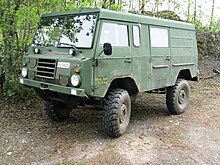Volvo C303
The Volvo C303 was an all-terrain vehicle made by the Swedish automaker Volvo in the 1970s. It is considered to be the "bigger brother" of the Volvo C202 , from which it differs fundamentally from a technical point of view.
They only have in common their box shape, and like the 202, the 303 has a ladder frame onto which the body is bolted directly. However, portal axles (probably from Salisbury, now Dana) are installed here (with cast Volvo lettering in the portal housing), which guarantee a ground clearance of 38 cm. The car is powered by the carburetor in - line six-cylinder petrol engine of the Volvo B30 A type, similar to the first copies of the Volvo 164 . The manual transmission (type S4-18 / 3 for the C303 and C304 and S5 / 18-3 for the C306 / TGB20) was contributed by the German supplier ZF Friedrichshafen . The transfer case is a Volvo design. There was the car, which was actually a small truck, with two and three axles. The designation changed from C303 to C304 or C306 depending on the total weight. Even a four-axle and an amphibious version were in the planning stage, but did not get beyond the prototype stage with a built vehicle. Differential locks on all axles gave this vehicle high off-road mobility. Today only a few of these SUVs are still on the roads of the world.
The C303 / 6 was built from 1974 to 1980 in an estimated number of 8,000 units. A C303 won the 1983 Paris-Dakar Rally in the light truck class. The racing vehicle was only supplemented by a roll bar and a larger tank, the rest corresponded to the series condition.

